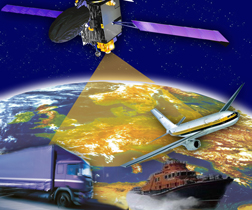The European Space Agency (ESA)-funded SRX project (‘SW-Defined Receiver for eXact PNT’) has developed a prototype multi-frequency, multi-GNSS receiver offering high-precision positioning and heading capability in adverse signal environments like forests.
The forestry sector is in need of reliable and accurate positioning, navigation and timing (PNT) solutions. In tree harvesting, logging trails need to be generated and then found again by large, heavy-duty logging machines, so they and their human operators can stay safe and on track. Individual cut tree positions need to be plotted by harvesters so that forwarders, specialized vehicles that extract cut logs from the forest, can locate them. The current logging-trail demand is for a positioning accuracy of about 0.5m, with high availability.
The SRX project was carried out by satellite navigation specialists IFEN and IGASPIN. Speaking at the project final presentation, hosted by ESA, IFEN’s Jürgen Pielmeier said, “We have no precise GNSS PVT [position, velocity, and time] technology that works the way we need it to work in the forest. Today, the best we can do is about five- to ten-meter accuracy. So we have to find a better solution to support today’s digital flow chain requirements.”
The main problem, it goes without saying, is the trees. In a typical timber forest, a limited amount of degraded GNSS signals from satellites above about 32 degrees elevation in the sky are usable, while only signals coming from above 60 to 80 degrees are open sky.
New generation SDR
Using a previously existing IFEN GNSS receiver as a starting point, the project developed a new prototype software-defined receiver (SDR) that features improved size, weight, and power (SWaP), and increased flexibility and scalability.
This robust, vector tracking-based solution for reliable, high-precision PNT uses Galileo E5ab and BeiDou-3 B2, ACE-BOC (asymmetric constant envelope binary offset carrier) wide-band signals, integrated with micro-electro-mechanical systems (MEMS) sensor measurements. The receiver also features the latest, state-of-the-art hardware innovations in radio frequency application-specific integrated circuits (RF-ASICs), with a system-on-a-chip (SoC) digital processor. High processing scalability enables coverage of the increasing number of GNSS satellites in orbit, while high processing flexibility allows the implementation of very complex signal and navigation processing algorithms.
At the heart of the system is a sophisticated RTK-enabled vector-tracking algorithmic solution, which project partners have described as ‘beyond the state-of-the-art’. The new SRX receiver provides improved PVT capability based on RTK and a multi-correlator approach, with environmentally-adaptive tracking loops and innovative strategies against anomalies.
Summing up, Pielmeier said field tests show the new prototype receiver enhances precise GNSS positioning in challenging environments, with effective multipath mitigation enabling excellent the meeting of our accuracy targets in forests but also in urban canyons and similar settings.






